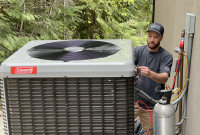Support strong Canadian climate journalism for 2025
The current cost-of-living crunch includes the bills to heat your home and turn on the lights. Ontario natural gas consumers saw a price increase on Oct. 1.
Unaffordable energy bills means people must decide between paying for utilities or groceries. Inadequate heating or cooling leads to health problems and structural damage to buildings. Low- to moderate-income Canadians are the most vulnerable.
The federal government is trying to manage these cost-of-living struggles while reducing the emissions that cause climate change. It seems like an ideal time to expand energy efficiency, which reduces emissions and costs.
Improving energy efficiency for low-income households requires urgent attention because the Canadians most vulnerable to rising energy costs are left out of federal policy. The Canada Greener Homes Initiative, which offers grants and loans to share the cost of energy upgrades, is not accessible to low- to moderate-income Canadians who can’t pay upfront costs or take on more debt.
The federal government recently recognized the need to tailor energy efficiency to eliminate these barriers when Environment and Climate Change Minister Steven Guilbeault announced funds to help low-income Canadians transition off heating oil. Yet, restricting support to heating oil does little to address electricity and natural gas usage, which make up 90 per cent of low-income energy costs, on average, based on the latest household spending data from Statistics Canada.
Canada must design an energy efficiency strategy for all Canadians to achieve net-zero emissions, while we reduce energy poverty and fight inflation. No-cost and turnkey upgrades would eliminate financial barriers for low-income households. The federal government can quickly bolster existing programs in provinces, territories and municipalities to achieve deeper energy savings and switch to low-carbon heating sources.
Federal support can further prioritize making homes healthier and safer through measures such as mold remediation and replacing hazardous electrical wiring. Tenants could trigger upgrades in their buildings, especially if they need services like air conditioning to protect against extreme heat. Landlords would improve their buildings if they agree to keep rents affordable.
Low-income energy efficiency makes sense from a macro policy perspective because targeting new spending to those most impacted by rising energy costs is a way to provide relief without driving broad demand increases in the economy that could contribute to inflation. Reducing energy demands can also have an anti-inflationary effect in energy markets.
We can also reduce labour shortages in the skilled trades by actively recruiting people from traditionally underrepresented populations to design, administer and implement a low-income energy efficiency program. This helps reach more people in need by breaking down language and cultural barriers.
A strategic approach to low-income energy efficiency will also alleviate supply chain bottlenecks that contribute to inflation. Because all upgrades are administered by the program, it is easier to co-ordinate bulk purchasing of equipment and materials, time upgrades with local market conditions and provide the demand-side certainty suppliers need to invest in training and productivity improvements.
For these reasons, policymakers shouldn’t use inflation as an excuse to delay public investments in low-income energy efficiency. People need help now, and a well-designed approach can tackle sector-specific inflationary challenges.
Canada will not be alone in prioritizing low-income energy efficiency. In the United States, the Weatherization Assistance Program has been upgrading low-income homes since the 1970s. Funding for this program was recently increased in the Bipartisan Infrastructure Law, and the Inflation Reduction Act introduced measures to bolster support for low- to moderate-income homes. We can catch up to the U.S. and further modernize low-income efficiency to deliver a net-zero emissions economy.
As the weather gets colder, let’s make sure all Canadians can save energy, regardless of their income level, where they live, or the fuel they use for heat. Given the double pressures of climate change and the cost of living, there is no better time for policymakers to support low-income energy efficiency.
Brendan Haley, PhD, is the director of policy research for Efficiency Canada, an energy efficiency research and advocacy organization based at Carleton University.
Abhilash Kantamneni is an Efficiency Canada research associate specializing in energy poverty and low-income energy efficiency.







Comments
"Reducing energy demands can also have an anti-inflationary effect in energy markets."
Nope. It increases the price per unit volume, because there is an idea that not only total revenues, but also dividends to shareholders must continually rise.
Consider what happened in Toronto when the Electricity delivery company started having to deliver less electricity.